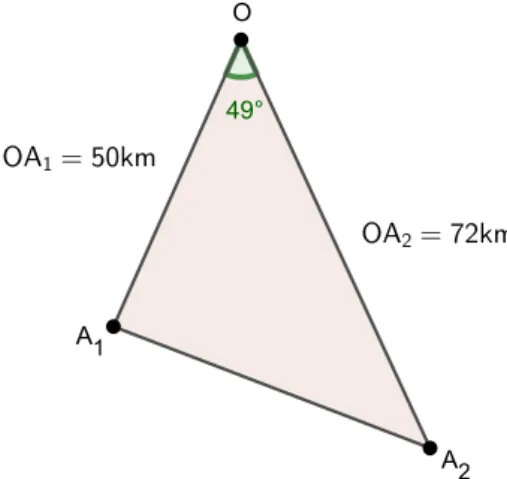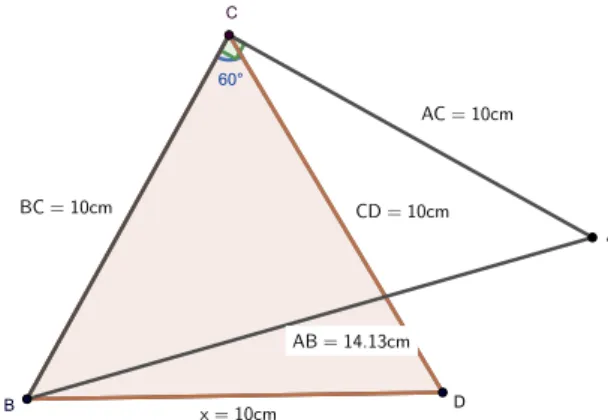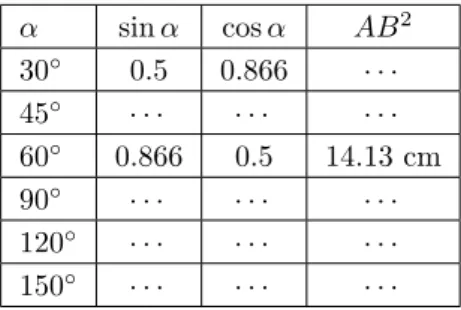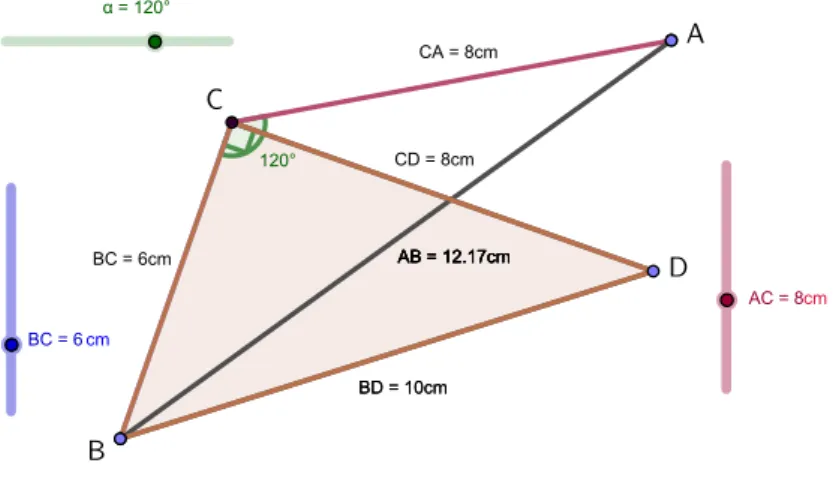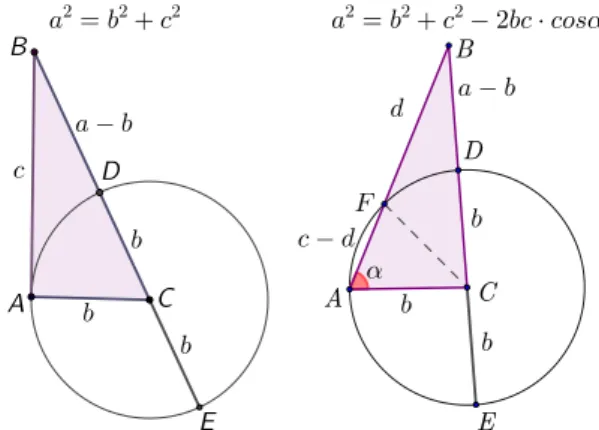Visual argumentations in teaching trigonometry
Francesco Laudano
Università degli studi del Molise francesco.laudano@unimol.it
Submitted: April 13, 2021 Accepted: October 13, 2021 Published online: October 22, 2021
Abstract
In this paper, we study the possibility of building a learning path that allows students to develop trigonometric knowledge and skills by the end of Grade 10 of secondary science-based schools. In particular, we describe an action research experiment, in part done through distance learning, aimed at incorporating all trigonometry topics within the framework of the study of Euclidean geometry. The inquiry-based learning methodology and the support of dynamic geometry software with a laboratory teaching approach were used. The learning path is based on several “visual/dynamic proof” and is explained by an example lesson on the Cosines Law.
The experiment could be extended by teachers into physical/virtual class- rooms and could offer practical strategies and tools for teaching trigonometry.
Keywords: Trigonometric path, Euclidean geometry, trigonometric relation- ships, visual proofs
AMS Subject Classification:97G10, 97G60
1. Introduction
The multiple applications of trigonometry have made it a fundamental milestone in the training of students, which has led many governments to introduce the study of this topic since the first year of secondary science-based schools. This practice can be seen, for example, in Canada ([13, 14]), France ([8–10]), Hungary ([6]), doi: https://doi.org/10.33039/ami.2021.10.002
url: https://ami.uni-eszterhazy.hu
183
Italy ([11]), the UK ([5]), and the USA ([1]). However, the study of trigonom- etry is performed mainly in the third and fourth years, probably because some trigonometric reasoning seems too abstract for 14- to 15-year-old students. More- over, as highlighted in [2], the learning of trigonometry is a highly difficult area of mathematics for both students and teachers. Furthermore, learning outcomes are strongly influenced by the teaching approach, which in some cases points towards the application of trigonometric relations, almost entirely omitting proofs, and in other cases, in contrast, emphasizes algebraic-formal aspects at the risk of losing students’ attention. In the following, without neglecting these two important as- pects of trigonometry training, we present a geometric path that allows to develop the applications of trigonometry without overlooking the educational potential of the proofs. The core idea, which is developed in the following, consists of incorpo- rating trigonometry into the elementary geometry path, replacing the classic formal arguments with visual and dynamic proofs, which are simpler to build, especially in distance learning. This is in order to improve students’ demonstrative skills, since, as pointed out in [18] and [7], even students who are particularly talented in mathematics, they still have difficulty in solving problems that require proof.
The experiment, in part done through distance learning, was built on the inquiry-based learning (IBL) methodology (see [4] for a literature review). The use of educational technologies in the teaching of trigonometry has been analyzed by Ross et al. [16] and can provide decisive help to teachers. Therefore, in the devel- opment of the path, dynamic geometry software (GDS) with a laboratory teaching approach was used. The construction of mathematical ideas is based upon real problems and follows the different phases of inquiry until students’ knowledge is deeply rooted through the relevant proofs.
2. The didactic project
Since the IBL is founded on concrete problems and stimulates questions and ac- tions to solve them, it seemed as the most suitable methodology to use in order to implement an innovative learning activity for students in G9–G10. The fun- damental ideas of IBL can be found in Dewey’s thought [3]. According to him, students build their knowledge and skills through a sequence of research stages, in which they formulate hypothesis, verify them and discuss the results of their in- vestigations [17]. The IBL activities are based on a workshop format: the teacher acts as a facilitator by guiding students’ development and exchange of ideas by asking them appropriate questions; students work in small groups and take active part in their learning process [15]. In the teaching of geometry, we start from a concrete problem and, after having identified its essence, we search for its solution.
In the activity that we describe, the basic idea consists of making students ob- serve and manipulate through GDS some geometric constructions which had been appropriately prepared, and then gradually direct students towards the discovery of the formulas and trigonometric theorems. In the next phase, the teacher raises
students’ awareness to the need to prove the relations that have been discovered, and guides them to the search of the proofs. Later, in order to establish the ef- fectiveness of the activity, the initial problem from which the activity started is solved by using the discovered properties. In the course of the didactic activities, we have tried to chain the evolution of geometric knowledge and students’ gratifi- cation in the awareness of their mutual influence. In particular, efforts have been made to concatenate the two aspects in order to trigger a virtuous circle in the learning process. In fact, we believe that the possibility of discovering “something new” provides pupils with a “motivational lever” that can be decisive for the devel- opment of skills. What is presented in Table 1 is the path that incorporates the study of trigonometry in the development of geometry, thus valuing also this part of Mathematics that is considered by many authors fundamental in the training of students’ logical abilities. The trigonometry Units are developed in greater detail in Table 2.
Table 1. Units, General outcomes and Chapters.
Unit General Outcome Chapter
Isometry Solve problems involving con- Congruences G9 gruence between polygons, us- Triangles
ing both measurements and ge- Quadrilaterals
ometric proofs Circles
Similarity Solve problems involving simi- Similarities G9 litude between polygons, using Triangles
both measurements and Circle geometric proofs
Trigonometry 1 Solve triangles using trigono- Trigonometric Ratios
G9 metric theorems Right Triangles
Any Triangles Equivalence Solve problems using trigono- Equivalences
G10 metric theorems Triangles and Trapezoids
Special𝑛-gons Euclidean Theorems Trigonometry 2 Solve problems involving trigo- Trigonometric Functions
G10 nometric functions using trigo- Trigonometric Identities nometric identities and trigo- Equations and Problems nometric equations
Table 2. Detail of the Trigonometry Chapters.
Unit Chapter Lesson
Trigonometry 1 Trigonometric Ratios Sine, Cosine, Tangent ratio Basic trigonometric identities The ratio of30∘, 60∘and 45∘ Right Triangle Pythagoren Theorem
Right Triangle Theorems Solving rigth triangles Any Triangle Triangle Area Formula
Length of a cord, Sines Law Cosines Law
Solving any triangles Trigonometry 2 Trigonometric Functions Graph of Trigonometric
Functions
Periodicity of trigonometric functions
Associated angles relations Trigonometric Identities Ptolemy’s identities
Double angle formulas Half angle formulas Product-sum identities Parametric formulas Equations and Problems Basic equations
Some non linear equation Application problems
3. A lesson plan on the Cosines Law
In this section, we describe an example lesson on Cosines Law directed to G9 students. In particular, we get an overview of how students discovered the cosine law while using dynamic geometry software in the classroom.
The activity, which lasts approximately 90 minutes, is conceived as a DGS lab and entailed the use of worksheets to guide the students to start the inquiry.
Objectives:
• Discover the Cosines Law.
• Proof Cosines Law.
• Solve problems using Cosines Law.
For this activity it seemed appropriate to give students many suggestions in order to guide their search in the right direction. Instead, for the activities that followed, suggestions were gradually reduced in order to make students become more and more autonomous in the management of the inquiry.
If we get an overview of how students discovered the cosine law while using dynamic geometry software in the classroom, there is no need to mention the test.
Step 1. Problem posing
Everyone knows the Pythagorean Theorem and how it allows to solve problems related to right triangles. But what happens when the problem concerns non-right triangles? I.e. consider the following text:
“An aircraft tracking station determines the distance from a common point 𝑂 to each aircraft and the angle between the aircraft. If angle 𝑂 between two aircraft is equal to 49∘ and the distances from point 𝑂 to the two aircraft are 50km and 72km, find distance between the two aircraft (round answers to 1 decimal place).”
Figure 1. Sketch of the problem.
After a few minutes of reflection followed by a teacher-led discussion, the stu- dents propose two possible solution strategies. The first starts by drawing a per- pendicular line from point𝐴1 to𝑂𝐴2 and applies the Pythagorean formula twice.
The second one starts from the GDS construction of a triangle𝐵1𝑃 𝐵2(similar to 𝐴1𝑂𝐴2), with𝐵1𝑃 = 5cm,𝑃 𝐵2= 7.2cm and𝐵1𝑃 𝐵̂︀ 2= 49∘and find the distance between the two aircraft multiplying the length of 𝐵1𝐵2 for the ratio 106. The teacher points out that both strategies are valid and general. However, a formula that expresses the length of one side of a triangle as a function of the other sides and the angle between them would make it possible to solve the problem more ef- fectively. Therefore the teacher invites the students to reflect and discuss to answer the following questions.
Question 1. In principle, could there be a general formula that expresses the length of one side of a triangle as a function of the other sides and the angle between them?
Some students point out that two sides and the angle between them uniquely de- termine all the triangle’s elements, so they concur that such a formula might exist.
Then, the teacher propose an investigation aimed at an extension of Pythagoras’
theorem that would be useful to solve the aircraft problem.
Step 2. Working with DGS
The search for the formula involves several stages. The first phase is aimed at discovering the role played by the angle and, in particular, at understanding which of the functionssin𝛼andcos𝛼could intervene in the formula. The teacher invites students to work on a file suitably prepared with DGS (see Figure 2) so that they can change the width of the angle𝐵𝐶𝐴̂︀ by acting on the slider, while𝐵𝐶 and𝐷𝐶 are segments with a given length equal to10cm.
Figure 2. Working with isosceles triangles.
Using the slider, students immediately realize that increasing the width of the angle𝐵𝐶𝐴̂︀ also increases the length of𝐴𝐵. Then the teacher guides them through the following questions and the related discussion.
Question 2. How does the value of 𝐴𝐵2 change as the sine and cosine of the angle𝛼?
To answer this question, the teacher invites the students to note down on a worksheet the sine and cosine values of the 30∘, 45∘, 60∘, 90∘, 120∘, 150∘ angles and the corresponding values of𝐴𝐵2.
Table 3. Relations betweensin𝛼,cos𝛼and𝐴𝐵2.
𝛼 sin𝛼 cos𝛼 𝐴𝐵2 30∘ 0.5 0.866 · · ·
45∘ · · · ·
60∘ 0.866 0.5 14.13cm
90∘ · · · ·
120∘ · · · ·
150∘ · · · ·
Comparing the relationships shown in the table, the students note that the value of the cosine constantly decreases as the angle increases. Instead that of the sine increases for0∘ < 𝛼≤90∘ while it decreases for 90∘ ≤𝛼 < 180∘. Therefore the length of𝐴𝐵does not seem to be related tosin𝛼.
Moreover, they observe that as𝛼increases, the quantity−cos𝛼increases, and so does the length of𝐴𝐵.
Therefore the teacher advises students to look for the more simple formula verifying the conditions that emerged with the use of the DSG. Then, since the relation sought must extend the Pythagorean theorem, it guides them through the following questions and related discussion.
Question 3. Can the formula be obtained from the Pythagorean relation by sub- tracting an appropriate quantity that depends oncos𝛼?
The teacher leads the discussion to obtain𝐴𝐵2by subtracting a term propor- tional to cos𝛼 from 𝐵𝐶2+𝐴𝐶2. Then he invites the students to calculate the proportionality factor in various cases using DGS from Figure 2, to answer the following question.
Question 4. What is the relationship between𝐴𝐵2 and𝛼in the previous cases?
The teacher checks that students, by calculating the quantities(𝐴𝐵2−𝐴𝐶2− 𝐵𝐶2)/cos𝛼, always get the value200, as𝛼changes. Then it check to see if students really discover that𝐴𝐵2= 100 + 100−2·100 cos𝛼.
Therefore, the teacher invites students to modify the length of𝐴𝐶 and𝐵𝐶 to check if the above relation can be extended to other isosceles triangles. By carrying out these tests, students discover the formula𝐴𝐵2=𝐴𝐶2+𝐵𝐶2−2·𝐴𝐵·𝐵𝐶·cos𝛼 for isosceles triangles.
In the next phase, the teacher makes the students check if the formula they have just found can be extended to the scalene triangle 𝐵𝐶𝐷 in Figure 3. The related file has been prepared so that the students can change both the width of the angle 𝐵𝐶𝐷̂︀ and the length of𝐵𝐶 and𝐷𝐶, using the dynamism of the software. As for isosceles triangles, the teacher leads the discussion to obtain 𝐵𝐷2 by subtracting from 𝐵𝐶2+𝐶𝐷2 a term proportional to cos𝛼. Then, he invites the students to
calculate the proportionality factor in various cases through DGS to answer the following question.
Figure 3. Working with scalene triangles.
Question 5. Is the above relation still valid for the triangle𝐵𝐶𝐷 in Figure 3?
Students verify that as 𝛼 changes, the amount (𝐵𝐷2 −𝐵𝐶2−𝐶𝐷2)/cos𝛼 is constant. Then the teacher invites them to identify the algebraic relationship between𝐴𝐵, 𝐵𝐶 and this factor, and check to see if students really discover that 𝐴𝐵2= 36 + 64−2·6·8 cos𝛼. At this point, the teacher invites the students to modify the length of sides 𝐴𝐶 and𝐵𝐶 using the related sliders, to extend to any scalene triangles the relationship between the proportionality constant and their lengths. In this way the students discover that the above formula could hold for every triangle.
Step 3. Formulating a conjecture
The teacher proposes to students to build more triangles, using the prepared DGS file, to test the formula we seem to have discovered. The questions posed by the teacher guide the students in formulating the conjecture.
Question 6. Is the above relation still valid for any triangle, in particular for obtuse triangles?
Question 7. At this point, can we formulate a conjecture to generalize the Pythago- rean Theorem?
From the previous observations the students obtain the formula 𝐴𝐵2=𝐴𝐶2+𝐵𝐶2−2·𝐴𝐵·𝐵𝐶·cos𝛼.
Through the next question and the peer discussion that follows, the teacher lets emerge the need for a proof.
Question 8. Can we be sure that the previous formula holds for all triangles?
Step 4. Proving the law
Since the formula to prove is an extension of Pythagorean Theorem, the teacher proposes to prove it by trying to generalize a proof of this Theorem. In particular, he suggests starting from the recently studied proof, which showed in the left of Figure 4, based on Tangent-Secant Theorem.
Question 9. Can the reasoning showed in the left side of Figure 4 be extended to non-right triangles?
If necessary, the teacher suggests to use the Two Secant Theorem, since it nat- urally extends the Tangent-Secant Theorem, and guide students in understanding proof. In the right side of the Figure 4 we show a sketch of the proof, that will only be shown to pupils if they can’t find out for themselves.
Figure 4. In the left we have (𝑎+𝑏) : 𝑐 =𝑐 : (𝑎−𝑏), i.e. the Pythagorean Theorem. In the right we have(𝑎+𝑏) :𝑐=𝑑: (𝑎−𝑏)
and𝑐−𝑑= 2𝑏·cos𝛼, hence the Cosines Law.
Step 5. Solving the problem
At this point the teacher points out to the students that they have the tools to solve the initial problem and asks them to find the solution. He also invites them to reflect and discuss by asking the following questions.
Question 10. What kind of problems can we solve by using the Cosines Law?
Question 11. Can we find another way to solve the aircraft problem?
Question 12. Can we find another way to prove the Cosines Law?
4. Conclusions
The experimentation of the path that we have presented involved approximately 100 pupils from different geographical and socio-cultural backgrounds. At the end
of each unit the efficiency of the activity was assessed by considering the following aspects:
• students’ ability to complete the research path by discovering and formulating the theorems that have been studied, and in particular the trigonometric relations;
• students’ ability to use the acquired knowledge to solve applied problems.
The data collection was of an exploratory research; therefore, it could be con- sidered only as a prelude to a more in-depth research plan aimed at comparing the results obtained using more traditional teaching approaches. In particular, we consider it appropriate to analyze the levels reached by students, according to van Hiele classification [19].
With this work we want also to highlight the importance of geometric reasoning in the didactic field, also due to the fact that in the last decade the teaching of Euclidean geometry in secondary schools seems to have lost its vigor. Yet, this part of mathematics is considered fundamental in the development of students’ logical abilities by many authors [12].
While taking into account the limitations of our research, the initial results obtained by the students, if confirmed by further and more in-depth experiments, seem to indicate the achievement of the objectives of the experimentation. In particular, the visual/dynamic proofs seemed to be useful in the DL, where it is more difficult to maintain students’ attention on long formal argumentations, whereas it would be more effective to stimulate them to think about geometric figures.
References
[1] Common Core State Standards Initiative:Mathematics Standards for Mathematics, Common Core State Standards Initiative, 2020,
url:http://www.corestandards.org/Math/.
[2] A. T. Delice,T. Roper:Implications of a comparative study for mathematics education in the English education system, Teaching Mathematics and its applications 25.3 (2006), pp. 64–72,
doi:https://doi.org/10.1145/1073204.1073229.
[3] J. Dewey:Experience and education, New York: Macmillan, 1983, doi:https://doi.org/10.1007/978-3-642-56432-1.
[4] J. Dreye,D. M. Larsen,M. D. Hjelmborg,C. Michelsen,M. Misfeldtand:Inquiry- based learning in mathematics education: important themes in the literature. In Research of Department of Mathematics and Science Education, Stockholm: Stockholm University, 2016,
doi:https://doi.org/10.1007/978-3-642-56432-1.
[5] English Department for Education:Mathematics GCSE subject content and assessment objectives. 2013, London: Department for Education, 2013,
url:https://assets.publishing.service.gov.uk/government/uploads/system/uploads/
attachment_data/file/254441/GCSE_mathematics_subject_content_and_assessment_
objectives.pdf.
[6] Government of Hungary:The Hungarian National Core Curriculum, Magyar közlöny (official journal of Hungary): Government of Hungary, 2014,
url:https://ofi.oh.gov.hu/sites/default/files/ofipast/2014/04/NAT_2012_EN_
final_2014marc14.pdf.
[7] Á. Győry,E. Kónyab:Proving skills in geometry of secondary grammar school leavers specialized in mathematics, Annales Mathematicae et Informaticae 50 (2019), pp. 217–236, doi:https://doi.org/10.33039/ami.2019.11.003.
[8] Ministère de l’Éducation nationale et de la Jeunesse:Bulletin officiel nº,30 du 26- 7-2018 - Cycle 4. 2018, Paris: Ministère de l’Éducation nationale et de la Jeunesse, 2018, url:https://cache.media.eduscol.education.fr/file/30/62/8/ensel169_annexe3_
985628.pdf.
[9] Ministère de l’Éducation nationale et de la Jeunesse:Programme de mathématiques de première générale, Paris: Department for Education, 2019,
url:https://cache.media.education.gouv.fr/file/SP1-MEN-22-1-2019/16/8/spe632_
annexe_1063168.pdf.
[10] Ministère de l’Éducation nationale et de la Jeunesse:Programme de mathématiques de seconde générale et technologique, Paris: Department for Education, 2019,
url:https://cache.media.education.gouv.fr/file/SP1-MEN-22-1-2019/95/7/spe631_
annexe_1062957.pdf.
[11] Ministero dell’Istruzione dell’Università e della Ricerca:Schema di regolamento recante ’Indicazioni nazionali riguardanti gli obiettivi specifici di apprendimento concernenti le attivita’ e gli insegnamenti compresi nei piani degli studi previsti per i percorsi liceali, Roma: Ministero dell’Istruzione dell’Università e della Ricerca, 2010,
url:https://www.gazzettaufficiale.it/eli/id/2010/12/14/010G0232/sg.
[12] E. E. Moise:The meaning of Euclidean Geometry in school Mathematics, The Mathematics Teacher 68.6 (1975), pp. 472–477.
[13] Ontario Ministry of Education:The Ontario Curriculum Grades 11 and 12 Mathemat- ics 2007, Toronto: Queen’s Printer for Ontario, 2007,
url:http://www.edu.gov.on.ca/eng/curriculum/secondary/math1112currb.pdf.
[14] Ontario Ministry of Education:The Ontario Curriculum Grades 9 and 10 Mathematics 2005, Toronto: Queen’s Printer for Ontario, 2005,
url:http://www.edu.gov.on.ca/eng/curriculum/secondary/math910curr.pdf.
[15] C. Rasmussen,K. Marrongelle,O. N. Kwon,A. Hodge:Four goal for instructors using inquiry-based learning, Not Am Math Soc. 64.11 (2017), pp. 1308–1311.
[16] J. A. Ross,C. D. Bruce,T. M. Sibbald:Sequencing computer-assisted learning of trans- formations of trigonometric functions, Teaching Mathematics and its applications 30 (2011), pp. 120–137,
doi:https://doi.org/10.1080/0020739X.2019.1565453.
[17] M. Santos-Trigo:An inquiry approach to construct instructional trajectories based on the use of digital technologies, Eurasia J Math Sci Technol Educ. 4.4 (2008), pp. 347–357, doi:https://doi.org/10.12973/ejmste/75361.
[18] C. Szabó,C. Bereczky-Zámbó,A. Muzsnay,J. Szeibert:Students’ non-development in high school geometry, Annales Mathematicae et Informaticae 52 (2020), pp. 309–319, doi:https://doi.org/10.33039/ami.2020.12.004.
[19] Z. Usiskin:Van Hiele Levels and Achievement in Secondary School Geometry. CDASSG Project, Chicago, Illinois: Chicago University, 1982.


